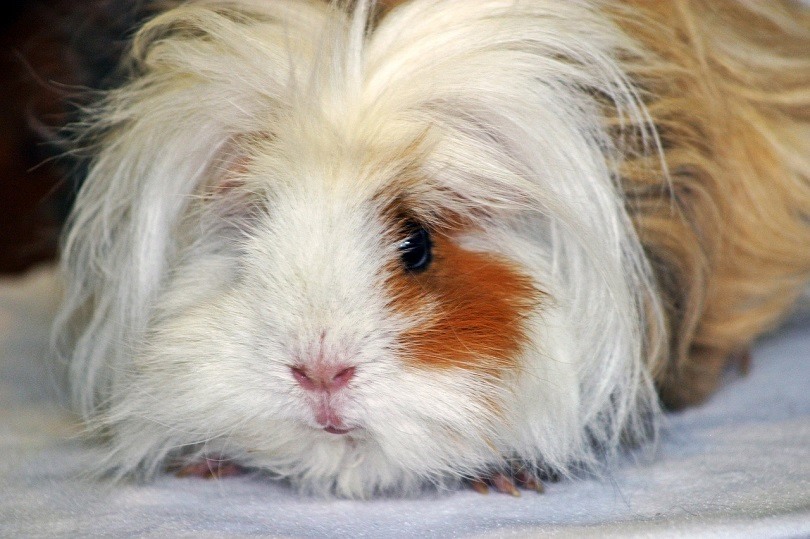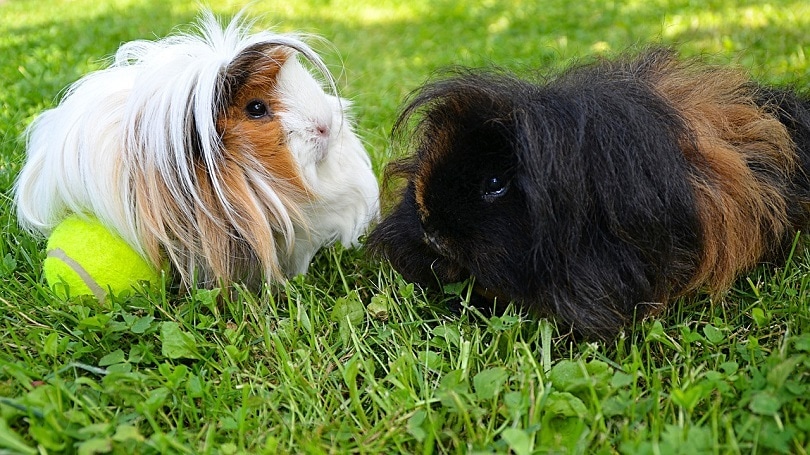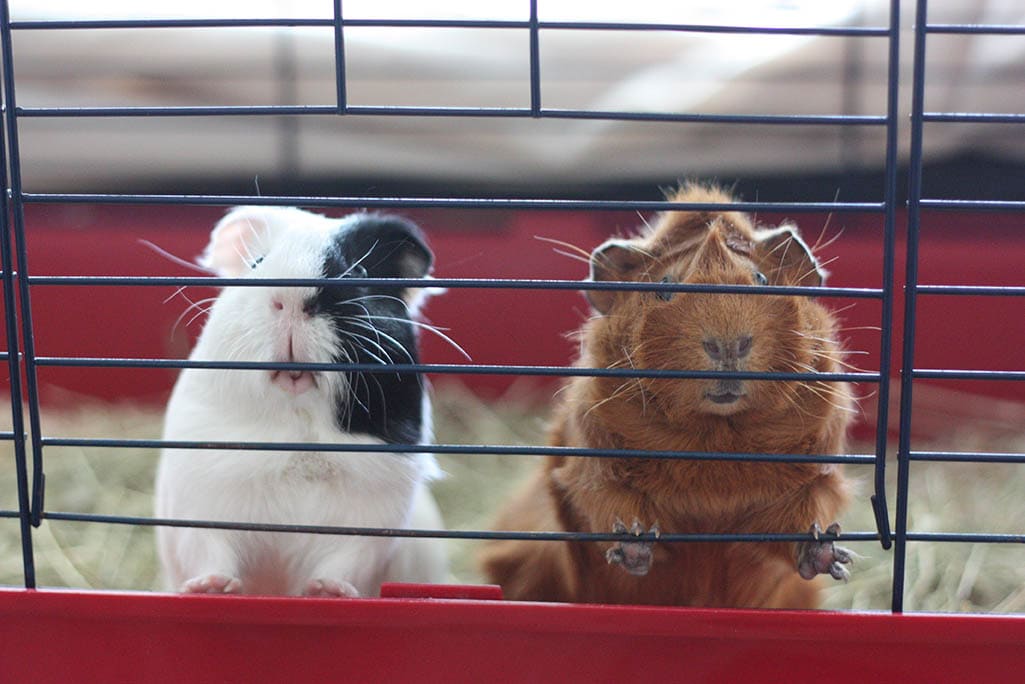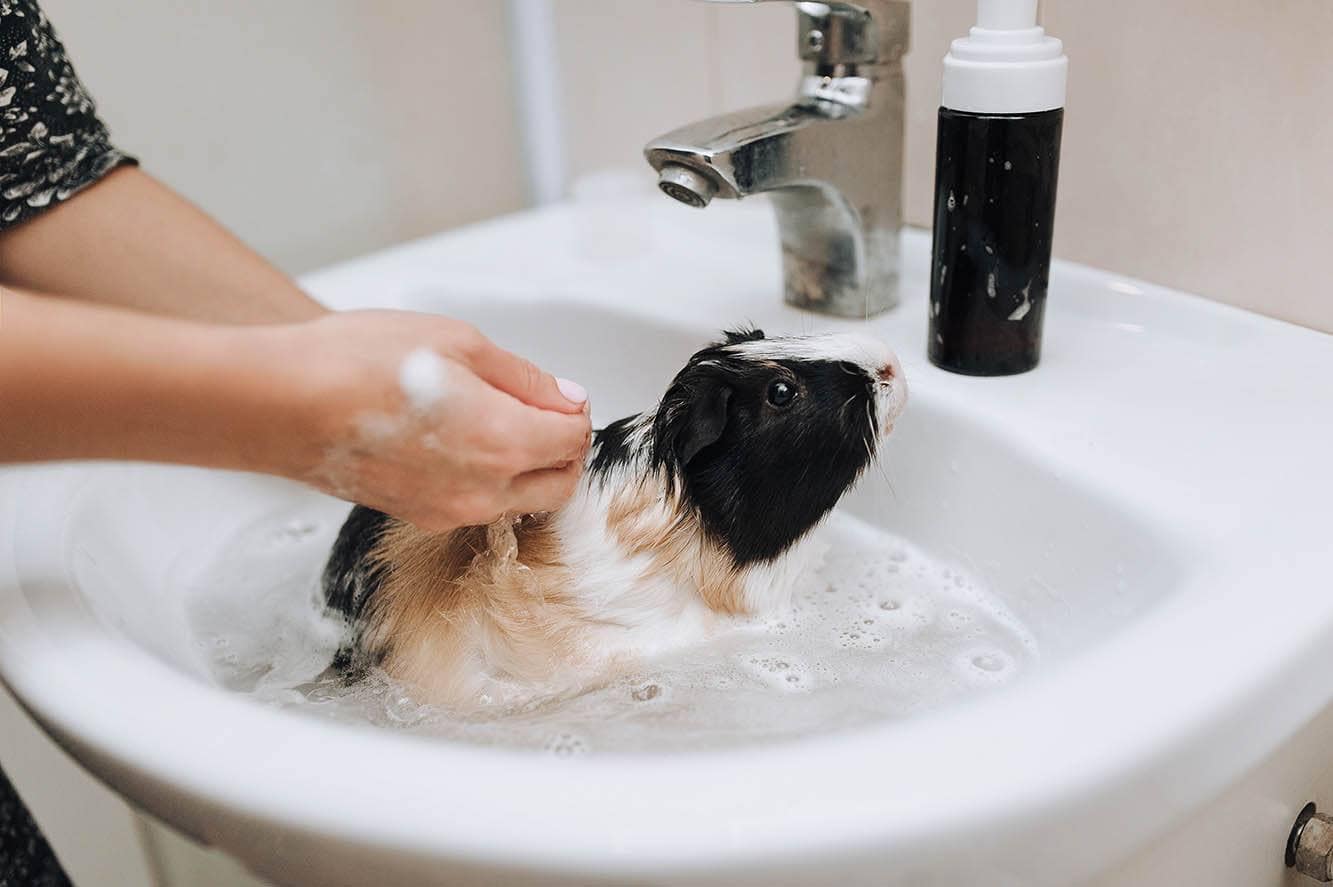
Click to Skip Ahead
The Lunkarya guinea pig is a uniquely furred breed that captures the hearts of all who see them despite their rarity. These sweet cavies are fluffy and well-mannered, but they have some interesting traits that mean they’re the talk of any cavy shows they frequent. Read on to discover more about what makes the majestic Lunkarya so special.
| Size: | Small |
| Weight: | Up to 2.2 lbs |
| Lifespan: | 5–6 years |
| Similar Breeds: | Coronet, Peruvian, Silkie |
| Suitable for: | Those wanting a rare breed, owners experienced with guinea pig grooming |
| Temperament: | Calm, playful, friendly |
The Lunkarya (pronounced “Lunka-ree-a”) is renowned for their wooly, sheep-like fur. It is similar to that of the Peruvian guinea pig but much thicker and curlier; it’s more akin to sheep’s wool than fur! These rare cavies are on the British Cavy Council’s Rare Varieties list. That’s not to say they don’t have variations, but they display different coat colors and patterns.
Lunkarya Guinea Pig Breed Characteristics
How Much Do These Guinea Pigs Cost?
Because of the rarity of the Lunkarya, finding an exact price proved very difficult! They are likely to be almost impossible to find in the US since they’re not currently recognized by the American Cavy Breeders Association (ACBA) and are rare, to begin with. Still, European prices seem to place the cavy at around $50.
The Lunkarya was discovered in Sweden when a curly-coated guinea pig was born into a litter of Peruvians. This remarkable baby resulted from a dominant curly gene known as a “rexoid mutant,” which gave the Lunkarya its distinctive, wooly appearance. Some speculated that the Lunkarya resulted from crossbreeding between Peruvians and other curly-haired breeds (such as the Texel), but the ringleted locks of the breed are unique and naturally occurring.

Temperament & Intelligence of the Lunkarya
The Lunkarya is a breed like all others in that they adore social interaction with fellow guinea pigs and need it to stay happy and healthy. The Lunkarya originated from the Peruvian, which is known to have a relaxed and easy-going temperament when well-socialized with humans. This socialization will affect the Lunkarya’s temperament most, as non-fearful and well-socialized individuals are likely to be outgoing, confident, and non-aggressive.
Like other intelligent cavies, the Lunkarya needs interaction and stimulation to keep them happy. They are also capable of learning tricks and mastering basic training, such as using a litter box, coming when called, and even shaking paws!
Do These guinea pigs Make Good Pets? 👪
The Lunkarya makes an excellent pet for those experienced with grooming longhaired guinea pigs! They have extensive grooming needs due to the coiled nature of their fur, so owners should be prepared to spend lots of time grooming them. The Lunkarya can suffer from severe and debilitating matting if they aren’t groomed properly.
Because the Lunkarya shares the relaxed and easygoing temperament of the Peruvian, they’re often a good choice for those with families. However, guinea pigs are easily startled and fragile; families with older children who can handle them respectfully are better suited to cavy ownership.
Does This guinea pig Get Along With Other Pets?
Cavies in the wild live in herds, so your Lunkarya will need at least one other guinea pig to allow them to exhibit natural behavior. Because of their relative fragility and small size, it’s safest not to mix your Lunkarya with any other pets in the household. You should never leave your guinea pig alone with predators such as cats or dogs, as they are prey animals that can easily become overwhelmed with fear (or badly hurt).
Things to Know When Owning a Lunkarya
Food & Diet Requirements 🥕
Your Lunkarya will need a varied and balanced diet to keep them healthy and in good shape. Guinea pigs, like rabbits, should have a diet of mainly hay or grass. Your Lunkarya should be fed as much hay as they can eat (and have it freely available), and it should make up around 90% of their daily diet.
Fiber is particularly important for longhaired breeds such as the Lunkarya, as it promotes good digestion and helps to prevent the build-up of hair in the digestive tract. It’s very important that your Lunkarya gets enough vitamin C. Guinea pigs cannot make it in their bodies, so they need supplemental vitamin C to stave off deficiency (scurvy).
A good mix of vegetables and leafy greens such as tomato, collard greens, and bell peppers should make up 5% of your Lunkarya’s diet. The remaining 5% should comprise a small amount of high-quality timothy hay pellets.
Vitamin C should be supplemented via a tablet or liquid in a daily dose recommended by your vet. Fresh water should also be given in a bowl or gravity-fed bottle for your Lunkarya to drink, and they should always have access to it.
Habitat & Enclosure Requirements 🏠
Guinea pigs need a large, secure space to nest and run around in. While cages are a valid option, guinea pigs are poor climbers; a high-sided (at least 12 inches) and secure run can serve them well. A bedding box is needed for security when sleeping, and separate areas for a litter tray and food can be established.
The minimum requirement for a Lunkarya guinea pig should be an enclosure or cage that’s 47.2” x 23.6” x 17.7”, but the bigger, the better! Remember that your enclosure should be big enough to house two cavies comfortably. If you keep your Lunkarya outside, consider a waterproof, covered enclosure with a raised bottom.
Exercise & Sleeping Needs 🐹
Lunkarya guinea pigs aren’t the most active breed but still need plenty of opportunities to exercise and display natural behavior. A large run is the best place to facilitate that; they can be kept safe and secure while having a large space to run around.
You should also provide a sleeping area for your guinea pigs, filled with soft bedding such as easily washable fabric. Covered or hooded sleeping areas such as igloos can give your Lunkarya a sense of security; just make sure it’s big enough for all the guinea pigs in your enclosure. They often like to sleep together!
Guinea pigs are diurnal, meaning they’re more active during the day; they should sleep on the same day-night cycle as you do, providing you lighten and darken the room they’re kept in accordingly. Your Lunkarya should never be confined to their sleeping quarters for too long since guinea pigs can suffer from health problems such as arthritis and muscle wastage if they’re unable to exercise.
Training
The Lunkarya are as intelligent as other guinea pigs, and they can learn basic training and tricks. Guinea pigs can learn how to come when they’re called and use the litter box, and they can even learn basic tricks such as spinning around and shaking paws.
Grooming ✂️
The Lunkarya has some of the most complex grooming needs of any guinea pig species. Like the Peruvian guinea pig, these cavies have long hair that needs daily brushing and regular washing to keep them clean and tangle-free. Because the hair is dense and curled, they are more likely to pick up debris from their environment; daily brushing is needed to keep them clean and comfortable.
Cleaning around their bottoms is important since they can often get soiled. This helps prevent painful conditions such as urine scalding or even fly strike, which is incredibly painful and often fatal. Getting your Lunkarya used to being groomed from a young age is important for that reason.
Lifespan and Health Conditions 🏥
Lunkarya guinea pigs can live for as long as other breeds, around 5 to 7 years. Like other breeds, they also have health conditions they are susceptible to:
Male vs Female
When looking at the gender of your cavy, you’ll see that there aren’t many visual differences between male and female Lunkarya guinea pigs. Some anecdotal evidence suggests boars (male guinea pigs) live longer than sows (female guinea pigs), but that has not been conclusively proven. Other than that, both males and females look very similar. It’s important to neuter or spay any Lunkaryas you plan on keeping together to avoid unwanted litters.
The 3 Little-Known Facts About Lunkarya
1. They Have Ringlet Curls
According to the British Cavy Council, Lunkaryas should have distinctive, prominent ringlet curls cascading down their bodies. The hair is coarse and thick, giving the overall impression of sheep’s wool rather than fluffy fur!
2. The Coat of a Lunkarya Grows Fast!
The Lunkarya’s fur should grow at around 1 inch per month, but the coat often looks much shorter due to how tight their curls are!
3. They Are Also Known As “Lunks.”
Pets often have unique nicknames, but “Lunk” is one of the strangest ones.
Final Thoughts
The Lunkarya guinea pig is a breed unlike any other. Their defined curls and coarse coat texture set them apart from other longhaired breeds, such as the Peruvian. The spontaneous mutation in the litter of Peruvians that founded the breed caused ringlets to form from the Peruvian’s soft and silky fur.
Lunkaryas are incredibly rare and can only be reliably found in Europe. However, despite the American Cavy Breeders Association not recognizing the breed, the British Cavy Council has placed them on its rare breeds list.
See also:
- Can Bearded Dragons Eat Grass? What You Need to Know
- Can Bearded Dragons Eat Broccoli? Everything You Need to Know
Featured Image Credit: Jolly-Sunshine, Pixabay








